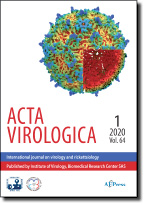Acta Virologica Vol.64, No.1, p.3-9, 2020
|
| Title: HIV-1: towards understanding the nature and quantifying the latent reservoir |
| Author: D. CHATZIDIMITRIOU, E. TSOTRIDOU, P. GRIGOROPOULOS, L. SKOURA |
|
Abstract: The human immunodeficiency virus (HIV)/acquired immune deficiency syndrome (AIDS) pandemic constitutes one of the greatest public health issues, since 36.9 million people worldwide were living with HIV in 2017 and 940,000 died from AIDS- related illnesses in the same year. One of the main obstacles in the effort to achieve viral eradication or long-term virologic remission is the existence of the HIV-reservoir. Except for resting memory CD4+ T cells there is a plethora of innate immunity cells including macrophages, dendritic cells, follicular T helper cells and NK cells which are now considered to play a role in viral latency and persistence. Hematopoietic precursor cells and progenitor mast cells, astrocytes, fibrocytes, renal and liver epithelial cells could also contribute to the reservoir, but their role remains controversial. Tissue reservoirs, such as the central nervous system (CNS), lymphoid tissue, adipose tissue and the gut-associated-lymphoid-tissue (GALT) are usually referred to as anatomic sanctuaries, where it is difficult to achieve high concentration and efficacy of antiretroviral agents. Accurate quantification of this reservoir is of the utmost importance and multiple assays have been developed for this purpose. The role of several cell populations in viral latency needs to be clarified by further studies. Furthermore, there is an urgent need for new assays, which will accurately measure the size of the reservoir, which plays a key role in predicting the timing of viral rebound upon cessation of antiretroviral treatment, since the currently available ones either overestimate or underestimate the size and have significant limitations.
|
|
| Keywords: HIV-1; cellular reservoirs; tissue reservoirs; quantification |
|
|
Published online: 11-Mar-2020
|
| Year: 2020, Volume: 64, Issue: 1 |
Page From: 3, Page To: 9 |
doi:10.4149/av_2020_101
|
|
 download file download file |
|
|
|
|
 download file
download file
